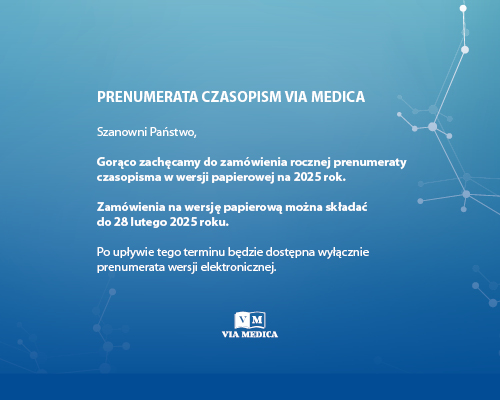Analysis of clinical features and pulmonary CT features of coronavirus disease 2019 (COVID-19) patients with diabetes mellitus
Abstract
Introduction: The objective of this paper was to investigate the clinical features and pulmonary CT imaging features of COVID-19 patients with diabetes mellitus.
Material and methods: From January 16, 2020 to March 28, 2020, among the 568 cases of COVID-19 patients diagnosed in Xiaogan Central Hospital, 64 cases of COVID-19 patients with diabetes were selected as the diabetic group, and 64 cases of COVID-19 patients with age and gender matching without diabetes were selected as the non-diabetic group, and their clinical data and pulmonary CT characteristics were retrospectively analysed.
Results: Compared with the non-diabetic group, the proportion of patients in the diabetic group with chronic underlying disease was higher, and they were in more a serious condition at admission. Inflammation index and characteristics of glycolipid metabolism results showed that COVID-19 patients with diabetes mellitus were more likely to have elevated inflammatory markers and hypercoagulability, accompanied by hypoproteinaemia and glucose and lipid metabolism disorders. Treatment and clinic outcome results showed that the time of nucleic acid turning negative in the diabetic group was significantly longer than that in the non-diabetic group. Radiological data showed that COVID-19 combined with diabetes prolonged the time of detoxification in patients.
Conclusion: COVID-19 patients with diabetes mellitus and chronic hypertension are associated with increased inflammatory markers and disorders of glucose and lipid metabolism. These patients tend to develop serious diseases, especially the rapid progression of CT lesions in the lungs of patients with a wide range of involvement, and prolonged absorption and detoxification time.
Keywords: COVID-19diabetesCT imagedetoxification time
References
- Weiss SR, Leibowitz JL. Coronavirus pathogenesis. Adv Virus Res. 2011; 81: 85–164.
- Masters PS, Perlman D. Coronaviridae. In: Knipe CD, Howley PM. ed. Fields virology. 6th ed. Lippincott Williams &Wilkins, Philadelphia 2013: 825–858.
- Su S, Wong G, Shi W, et al. Epidemiology, Genetic Recombination, and Pathogenesis of Coronaviruses. Trends Microbiol. 2016; 24(6): 490–502.
- Cui J, Li F, Shi ZL. Origin and evolution of pathogenic coronaviruses. Nat Rev Microbiol. 2019; 17(3): 181–192.
- Wong G, Liu W, Liu Y, et al. MERS, SARS, and Ebola: The Role of Super-Spreaders in Infectious Disease. Cell Host Microbe. 2015; 18(4): 398–401.
- Guan WJ, Ni ZY, Hu Yu, et al. China Medical Treatment Expert Group for Covid-19. Clinical Characteristics of Coronavirus Disease 2019 in China. N Engl J Med. 2020; 382(18): 1708–1720.
- Zhang C, Shi L, Wang FS. Liver injury in COVID-19: management and challenges. Lancet Gastroenterol Hepatol. 2020; 5(5): 428–430.
- Singer M, Deutschman CS, Seymour CW, et al. Sepsis Definitions Task Force. Assessment of Clinical Criteria for Sepsis: For the Third International Consensus Definitions for Sepsis and Septic Shock (Sepsis-3). JAMA. 2016; 315(8): 762–774.
- Sharma S, Adrogue JV, Golfman L, et al. Intramyocardial lipid accumulation in the failing human heart resembles the lipotoxic rat heart. FASEB J. 2004; 18(14): 1692–1700.
- Tang N, Li D, Wang X, et al. Abnormal coagulation parameters are associated with poor prognosis in patients with novel coronavirus pneumonia. J Thromb Haemost. 2020; 18(4): 844–847.
- Diagnosis and Treatment Protocol for Novel Coronavirus Pneumonia (Trial Version 7). Chin Med J. 2020; 133(9): 1087–1095.
- Diabetes Branch of Chinese Medical Association, National Basic Diabetes Prevention and Management Office. [National basic diabetes prevention and management guidelines (2018)]. Chin J Int Med. 2018; 57(12): 885–893.
- Kumar S, Maurya VK, Prasad AK, et al. Structural, glycosylation and antigenic variation between 2019 novel coronavirus (2019-nCoV) and SARS coronavirus (SARS-CoV). Virusdisease. 2020; 31(1): 13–21.
- Lu J, Gu J, Li K, et al. COVID-19 Outbreak Associated with Air Conditioning in Restaurant, Guangzhou, China, 2020. Emerg Infect Dis. 2020; 26(7): 1628–1631.
- Fahmi M, Kubota Y, Ito M. Nonstructural proteins NS7b and NS8 are likely to be phylogenetically associated with evolution of 2019-nCoV. Infect Genet Evol. 2020; 81: 104272.
- Liu Y, Yang Y, Zhang C, et al. Clinical and biochemical indexes from 2019-nCoV infected patients linked to viral loads and lung injury. Sci China Life Sci. 2020; 63(3): 364–374.
- Yang JK, Feng Y, Yuan MY, et al. Plasma glucose levels and diabetes are independent predictors for mortality and morbidity in patients with SARS. Diabet Med. 2006; 23(6): 623–628.
- Ma RCW, Holt RIG. COVID-19 and diabetes. Diabet Med. 2020; 37(5): 723–725.
- Klonoff DC, Umpierrez GE. Letter to the Editor: COVID-19 in patients with diabetes: Risk factors that increase morbidity. Metabolism. 2020; 108: 154224.
- Chan JF, Zhang A, Yuan S, et al. Simulation of the clinical and pathological manifestations of Coronavirus Disease 2019 (COVID-19) in golden Syrian hamster model: implications for disease pathogenesis and transmissibility. Clin Infect Dis. 2020; [ahead of print].
- Liu Q, Wang RS, Qu GQ, et al. [Gross examination report of a COVID-19 death autopsy]. Fa Yi Xue Za Zhi. 2020; 36(1): 21–23.
- Ding YQ, Bian XW. [Analysis of coronavirus disease-19 (COVID-19) based on SARS autopsy]. Zhonghua Bing Li Xue Za Zhi. 2020; 49(4): 291–293.
- Hanley B, Lucas SB, Youd E, et al. Autopsy in suspected COVID-19 cases. J Clin Pathol. 2020; 73(5): 239–242.



